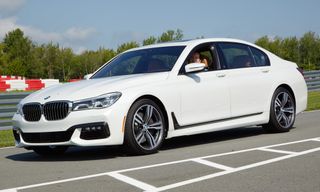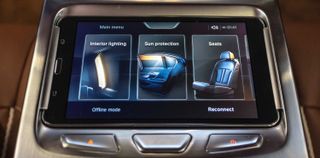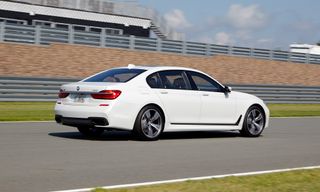BMW 7 Series Tested: Here's The Tech You Get for $100K
The BMW 7 Series offers a novel gesture-recognition system and super-smart cruise control in a very luxurious ride.
A buxom luxury sedan getting tossed around on a racetrack? The idea seemed preposterous, but there was a method behind BMW's madness in demonstrating its new 7 Series ($97,400 as tested). The 750i xDrive turned out to be the best way to prove that a raft of technological improvements could translate into agility as well as comfort.
The 2016 750i xDrive is the company's all-new flagship model — a chance to strut its stuff — and in this day and age, that means a lot of new technology. Most of the upgrades can also be found in other cars competing in the near-$100,000 category, but BMW notes that there are about a dozen improvements that it calls industry firsts for a luxury sedan, including a gesture-recognition camera system, a key fob with an LCD status display screen, and a carbon-fiber-reinforced cabin (something usually reserved for exotic sports cars).
The most desired feature — completely autonomous remote-control parking — won't be available at launch in the U.S., but there are plenty of other reasons to love this Bimmer.

In-Dash Tech
The new iDrive system gives you several points of access so that you can use the 12-inch touch screen, voice commands, gestures or the iDrive wheel mounted near the shifter. You can swipe through selections on the main screen, which include navigation, entertainment and vehicle settings.
A hand wave will reject a call, and there's a customizable two-finger pointing maneuver that can be used to, say, skip tracks.
The system is pretty smart. For example, if you start to enter an address using the iDrive controller in tandem with the completely confusing on-screen rotary interface but then move your finger toward the screen, the gesture system will recognize the movement and immediately switch to an on-screen touch-sensitive keyboard.
Gestures are limited to six different hand-waving/finger-pointing commands, but they are useful and easy to master. A finger-spinning (think, "you're crazy") gesture in front of the screen will turn the volume up or down, for example. A hand wave will reject a call, and there's a customizable two-finger pointing maneuver that can be used to, say, skip tracks.
I'll admit that the iDrive controller has become easier over the years. You can rotate the knob to flip through menus, jog it sideways to go back to a previous menu, or push it in to make a selection. Current BMW owners will feel comfortable and pleased; newcomers will probably use the touch screen.
BMW has also added what it claims is the largest color heads-up display to the 7 Series. It's height-adjustable, and I found it invaluable. I might ignore a voice instruction or a warning chime, but I immediately noticed the next turn or speed warning in the heads-up display.
BMW supports about a dozen smartphone apps — including Pandora, Spotify and Glympse — but the company has decided that supporting CarPlay and Android Auto is not a priority in its luxury sedan this year. (It's not clear if the 7 Series will be upgradable, although Android Auto support is more likely in the future.) Live traffic is included, as are over-the-air map updates, for the first three years.
MORE: Android Auto FAQ: Everything You Need to Know
To pair your phone, the 7 Series supports NFC, making it a cinch to get the Bluetooth matchup right. There's also a wireless charger in the armrest, so you can keep the phone out of sight but powered up. I found it all seamless, testing it with a Samsung Galaxy S6.
An optional key fob with a color LCD touch screen can also be recharged in the armrest. The fob also lets drivers (especially neurotic ones) check on the car's status (Did I lock the car?), and perform tasks like remote start that are also usually available on a smartphone app. The fob is also probably being offered in advance of a hybrid version of the car, in which it will be much more useful.
The one weakness of BMW's connected car system — as with many others — is the voice-recognition system, which can be irritating. Trying to change the navigation destination while driving, for example, resulted in multiple mistakes. As with much less expensive systems, it will misinterpret an address and begin looking in a state halfway across the country (for example, in Oregon, rather than a city nearby in New Jersey).
A command to "Make driver's temperature 72 degrees" resulted in the system telling me how to change the AC using the manual touch-sensitive controls below the screen.
Driving Tech
Out on the open road, the 7 Series' adaptive cruise control with automatic stop and start was more precise than most at keeping a set driving distance from the car ahead. Most systems are slow to react when the car ahead picks up speed, but the 7 Series kept up smartly, without lurching forward. Coming to a full stop, the system seemed to remain engaged longer than others I've tested. At several stoplights, I didn't have to do anything to keep the brake on or to take off once the traffic in front of me started moving.
Small tugs on the wheel let me know that the lane-keeping system was working. When following another car, I was able to take my hands off the wheel and watch as the 750i stayed in the lane and kept its distance from the car ahead. (It works at speeds of up to 130 mph.) After the car drives for a few seconds on its own, the steering icon in the color heads-up display goes yellow, and then a chime sounds and the icon turns red to tell you to quit goofing around. You can go hands-free for a total of 15 seconds.
There's also a blind-spot detection system and a night-vision option I've tested in other BMWs that can pick out deer and bears along the side of the road. However, the best trick I found the 7 Series has to offer is a cruise-control setting that allows the system to recognize posted speed limits as they change and then slow and speed up the car to match. Goodbye, speeding tickets.
Although the remote-control parking system isn't available yet, there's plenty of other technological help in the form of a virtual bird's-eye view of the car and a 3D panoramic view of the vehicle. The two images appear as a split screen on the in-dash display. I found them to be remarkably accurate and realistic. After an errant turn, for example, I had to do a multipoint turn in a stranger's driveway, which was dutifully rendered — grass, gravel and all.
The best trick to cruise control setting that recognizes posted speed limits and slows the car to match. Goodbye, speeding tickets.
There are still some things driver-assist programs don't understand. As I approached a hill with an added slow right lane, for example, I began to peel off to the right-hand side, but the 750i tried to cajole me back into the fast lane. It decided to follow the yellow and broken white lines and assumed that because I hadn't signaled, that's where I should go (even though the correct maneuver was to veer right).
MORE: Connected Cars: A Guide to New Vehicle Technology
I also found that although the 750i was adept at following cars on its own, on a narrow two-laner, it was less attentive in keeping within the lines — a reminder that these are driver-assist technologies, not autonomous features.
The 750i xDrive boasts virtual 3D, overhead views and loads of sensors to help you park. In other words, there's no excuse for tapping a bumper in the 7 Series. BMW will offer the fully autonomous self-parking system demonstrated in the i3 in the 750i — but only in Europe at first. The feature will enable the car to park itself while the "driver" stands on the sidewalk. Several BMW reps I spoke with were confident that the tech will be able to meet stateside regulations next year.
The Drive
BMW has lengthened, lightened and stiffened its big four-door sedan. It's an inch longer (206.6 inches) and 290 pounds lighter than last year's model, and it's now reinforced with carbon-fiber pieces.
Inside, the seats are more flexible than an Olympic gymnast. All the adjustments are animated on the in-dash display, so you know what button does what; there are massage settings; and there are even heated armrests.

The 750i xDrive's aluminum-and-wood appointments scream oligarch, and there's LED starlike lighting in the moonroof (no doubt inspired by subsidiary Rolls-Royce's constellation optic-fiber lighting). Our model was powered by a 4.4-liter twin turbo V8 with an 8-speed automatic transmission and paddle shifters, should you decide that you know better than the car.
BMW calls the V8 power plant a TU, or technical update. It's swifter but still has the throaty staccato BMW sound when you stamp on the accelerator (and I did plenty of that). It picks up speed neatly, going from 0 to 60 in 4.3 seconds, according to BMW.
There was no reason to doubt the ratings after repeatedly slinging the car around a racetrack and catapulting the vehicle through emergency lane-change tests, a short slalom course and multiple panic stops.
In sport mode, the 7 Series is quick to turn in, with virtually no steering lag, and on the slalom course, the four-door stayed flat and polite through the turns, even when I purposely pushed wider trying to get the car to sway. Using the comfort setting, things were considerably swoopier; there's also an Eco Mode, which will uncouple the powertrain in coasting situations and deliver a driver report card on the iDrive in-dash system if you want to see how efficiently you're driving. I stuck with the Sport Mode.
On the track, the most pronounced change to me from 7 Series of yore was that under severe braking into corners, it did not feel like a heavyweight. (This particular model weighs nearly 6,000 pounds.) Usually, when you slam on the brakes, the heft of a big vehicle feels cumbersome, as all the energy is thrown forward onto the front wheels; the 750i not only maintained its composure but remained light to the touch as I steered through corners and over the curbing.

There are several elements that contribute to the better handling, including the lighter weight, a new "kinetic" front suspension and axle, and the optional active four-wheel steering. For the first time, the active steering is available on the all-wheel-drive xDrive so that the rear wheels turn in the opposite direction at low speeds to reduce the turning radius, or in the same direction at high speeds to improve cornering. It all felt seamless to me on the racetrack.
On a much more relaxing drive through the countryside, the 750i xDrive felt nimble enough, with a dynamic air suspension system that sets the car lower in Sport Mode but at the push of a button will raise the vehicle 20 mm to accommodate steep garage openings and rougher roads. There is also a Road Preview option that uses a camera to look ahead on the road for potholes and other aberrations and then adjusts the suspension accordingly. (A similar option is available on the Mercedes-Benz S-Class.)
If there were times when the 7 Series did not behave like a 3 Series it was coming out of corners, where I felt a slight lag. But with all the tech under the skin and in the cabin, the 7 Series is still fun to drive.
Drive It or Park It?
A hefty luxury sedan usually conveys a sense of, shall we say, maturity— plush but not exactly exciting. But the new 7 Series manages to feel youthful, and even spritely at times. It's a joy to drive and doesn't feel ponderous. If you're in the tax bracket that can afford the 7 Series, get the 750i xDrive with all the amenities; you won't be disappointed.
BMW is trying to retake the luxury-sedan crown from Mercedes' S-Class. In many technological ways, it has certainly managed to match Mercedes. Of course, there's also competition from Tesla's S P85D, which has more sports-car-like performance but costs about $30,000 more while offering fewer luxury appointments.
For all the design work and impressive German engineering that has gone into the BMW 7 Series, I'm still waiting for the icing on the cake: the self-parking mode.
2016 BMW 7 Series: The Vitals
Price as tested: $97,400 MSRP (not including destination charges)
Engine and drivetrain: 4.4-liter twin turbo V8 with 8-speed automatic transmission and all-wheel drive.
Fuel rating: TBA
Connected car system: BMW iDrive 5.0 touch-screen in-dash system.
Safety technologies: Rear-view camera, lane-departure warning, collision warning, drowsy-driver warning, blind-spot warning, proximity alerts, cross traffic alerts, lane-keeping assist, night-vision system (optional).
Driver assist technologies: Adaptive cruise control with auto start and stop (up to 130 mph), active lane keeping/follow car (highway and traffic); parking assistance with virtual bird's-eye and 360 panoramic view.
Installed options: Heads-up display, Bowers & Wilkins Diamond sound system, Autobahn package with active steering.
Availability: October 2015
Sign up to get the BEST of Tom’s Guide direct to your inbox.
Upgrade your life with a daily dose of the biggest tech news, lifestyle hacks and our curated analysis. Be the first to know about cutting-edge gadgets and the hottest deals.
John R. Quain has been reviewing and testing video and audio equipment for more than 20 years. For Tom's Guide, he has reviewed televisions, HDTV antennas, electric bikes, electric cars, as well as other outdoor equipment. He is currently a contributor to The New York Times and the CBS News television program.

